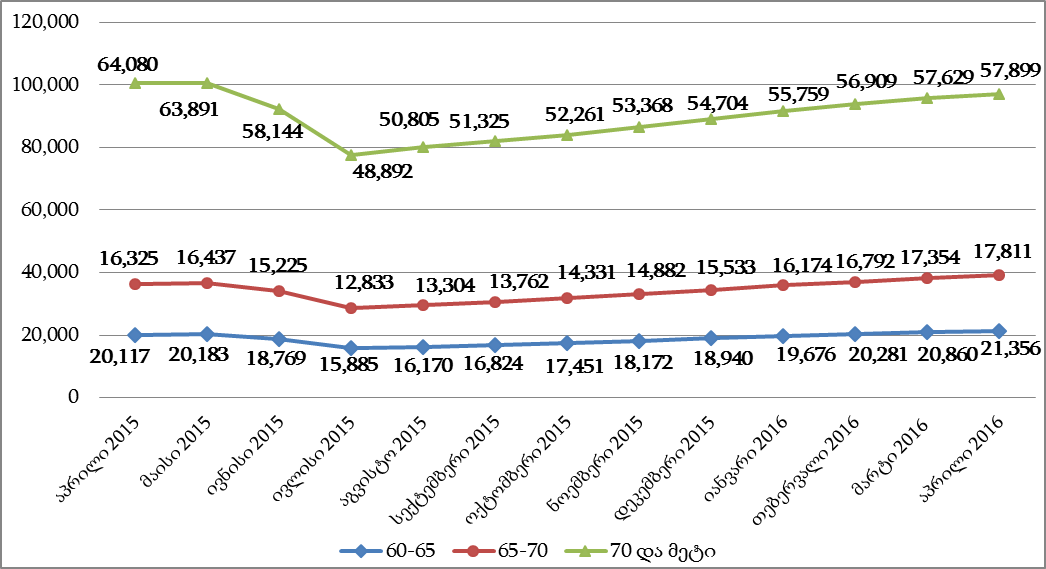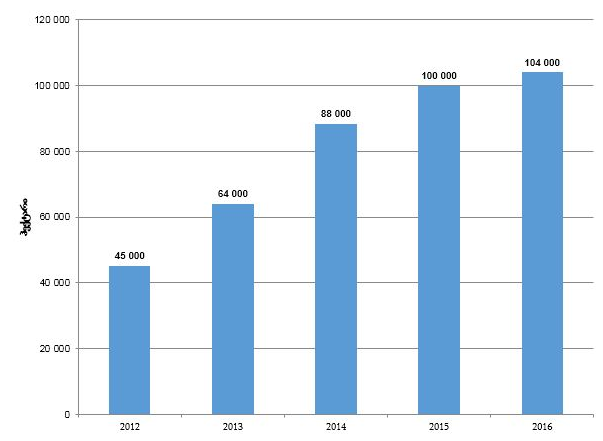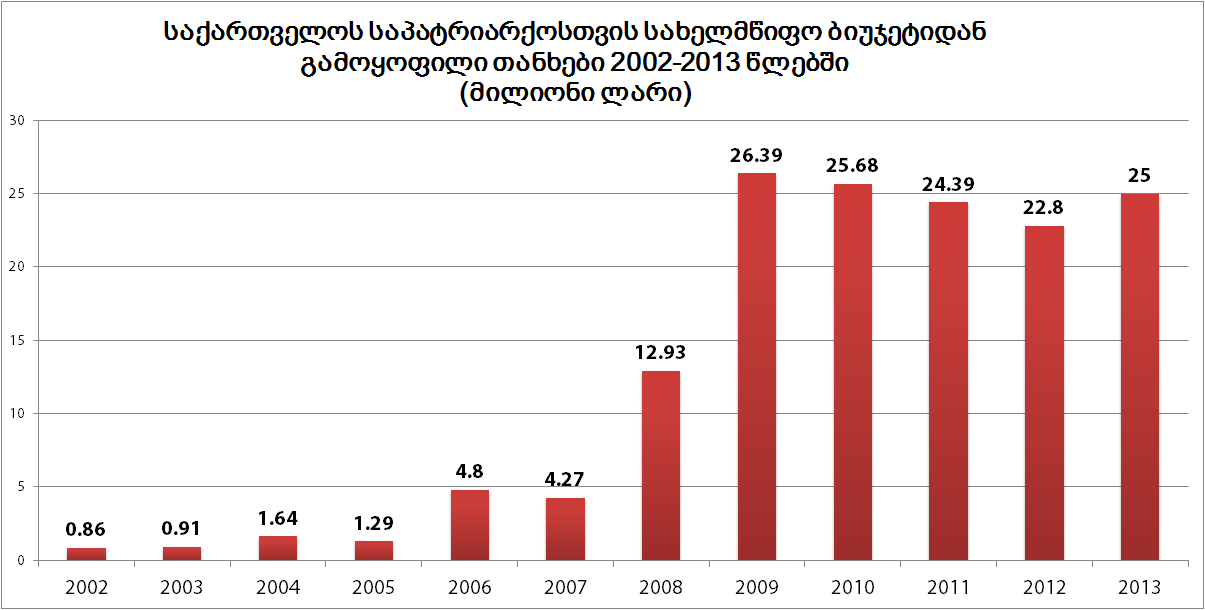According to the statement of the member of the United National Movement, Mikheil Machavariani: "One hundred days have passed since Bidzina Ivanishvili appointed Giorgi Kvirikashvili as the Prime Minister of Georgia. In what conditions does Georgia meet these 100 days of Mr Kvirikashvili’s premiership? – The lowest economic growth in the past five years and an enormous amount of domestic and external debts, at USD 15 billion, which is the highest number in the history of independent Georgia. In the past five years, Georgia’s lowest export amount was recorded in 2011, at USD 291 million, whilst this number is USD 281 million in 2016. And this is even more surprising as neither the Russian market nor the Association Agreement with the European Union were available to us in 2011."
According to the data of the first quarter of 2016, Georgia’s real economic growth was 2.3% which is 1.1% lower than in the same period of the previous year.
Chart 1: Real Economic Growth from 2004 to 2016
 Source: National Statistics Office of Georgia
An economic growth rate lower than it was in the first quarter of 2016 was last recorded in the same period of 2009 (-4.9%) when the world was facing an economic crisis. The export data of the first quarter of 2016 are only greater than the data of the same period of 2010, amounting to USD 442.8 million (see Chart 2).
Chart 2: Trend of Exports in Yearly First Quarters (USD Million)
Source: National Statistics Office of Georgia
An economic growth rate lower than it was in the first quarter of 2016 was last recorded in the same period of 2009 (-4.9%) when the world was facing an economic crisis. The export data of the first quarter of 2016 are only greater than the data of the same period of 2010, amounting to USD 442.8 million (see Chart 2).
Chart 2: Trend of Exports in Yearly First Quarters (USD Million)
 Source: National Statistics Office of Georgia
Georgia’s overall external debt reached USD 15 billion in December 2015. It must be pointed out that this does not only include the government debt (public sector and the National Bank of Georgia) but that of the private sector as well.
Chart 3: Overall External Debt from 2009 to 2015
Source: National Statistics Office of Georgia
Georgia’s overall external debt reached USD 15 billion in December 2015. It must be pointed out that this does not only include the government debt (public sector and the National Bank of Georgia) but that of the private sector as well.
Chart 3: Overall External Debt from 2009 to 2015
 Source: National Bank of Georgia
When talking about a country’s external debt, it should be pointed out that the analysis of absolute numbers alone is not a widely accepted method. Theoretical studies of economics tell us that it is much more appropriate to assess the amount of a country’s debt with regard to its GDP. Chart 4 depicts the share of Georgia’s overall state debt (including both domestic and external debts) and external debt with regard to its nominal GDP.
Chart 4: Georgia’s Share of State Debt and External Debt with Regard to Nominal GDP
Source: National Bank of Georgia
When talking about a country’s external debt, it should be pointed out that the analysis of absolute numbers alone is not a widely accepted method. Theoretical studies of economics tell us that it is much more appropriate to assess the amount of a country’s debt with regard to its GDP. Chart 4 depicts the share of Georgia’s overall state debt (including both domestic and external debts) and external debt with regard to its nominal GDP.
Chart 4: Georgia’s Share of State Debt and External Debt with Regard to Nominal GDP
 Source: Ministry of Finance of Georgia
As the chart makes clear, the highest ratio of overall state debt and state external debt to the nominal GDP was recorded in 2010, amounting to 42.4% and 33.6%, respectively. These indicators were much higher in 2003 and 2004. Both indicators increased in 2015 with the share of the overall state debt in the nominal GDP amounting to 41.5% whilst the share of state external debt reached 32.6%. As for the current year, as of 30 April 2016, the state external debt has grown by USD 108 million as compared to 31 December 2015. However, due to the appreciation of the GEL exchange rate, the external debt in GEL decreased by GEL 470 million. The domestic debt increased by GEL 28 million from January to April 2016. The share of the state debt in the nominal GDP of the country dropped from 41.5% to 40%.
Conclusion
According to the data of the first quarter of 2016, Georgia’s economic growth rate equalled 2.3% which is the lowest in the past five years. If we look at the past decade, it only exceeds the rate of the same quarter of 2009 which was a post-crisis period. The amount of exports is also at its lowest in the past five years, both according to the data of the first two months of 2016, as stated by the MP, as well as according to the data of this year’s first quarter in general.
When talking about debts, however, it must be pointed out that the stated amount of USD 15 billion includes both government debt as well as that of the private sector. More specifically, the state external debt amounts to USD 4.6 billion as of 2016 which is USD 224 million less than in 2012. In addition, whilst analysing state debt it is more widely accepted to compare it with the nominal GDP of the country rather than looking at absolute numbers alone. As of 31 December 2015, the overall state debt amounted to 41.5% of the nominal GDP whilst the state external debt was 32.6%. Historically, these data are lower than those of the years 2003-2004 and, more recently, of 2010. It should also be pointed out that the state debt with regard to the nominal GDP has not increased in the 100 days of Giorgi Kvirikashvili’s premiership. On the contrary, it has decreased.
FactCheck concludes that Mikheil Machavariani’s statement is HALF TRUE.
Source: Ministry of Finance of Georgia
As the chart makes clear, the highest ratio of overall state debt and state external debt to the nominal GDP was recorded in 2010, amounting to 42.4% and 33.6%, respectively. These indicators were much higher in 2003 and 2004. Both indicators increased in 2015 with the share of the overall state debt in the nominal GDP amounting to 41.5% whilst the share of state external debt reached 32.6%. As for the current year, as of 30 April 2016, the state external debt has grown by USD 108 million as compared to 31 December 2015. However, due to the appreciation of the GEL exchange rate, the external debt in GEL decreased by GEL 470 million. The domestic debt increased by GEL 28 million from January to April 2016. The share of the state debt in the nominal GDP of the country dropped from 41.5% to 40%.
Conclusion
According to the data of the first quarter of 2016, Georgia’s economic growth rate equalled 2.3% which is the lowest in the past five years. If we look at the past decade, it only exceeds the rate of the same quarter of 2009 which was a post-crisis period. The amount of exports is also at its lowest in the past five years, both according to the data of the first two months of 2016, as stated by the MP, as well as according to the data of this year’s first quarter in general.
When talking about debts, however, it must be pointed out that the stated amount of USD 15 billion includes both government debt as well as that of the private sector. More specifically, the state external debt amounts to USD 4.6 billion as of 2016 which is USD 224 million less than in 2012. In addition, whilst analysing state debt it is more widely accepted to compare it with the nominal GDP of the country rather than looking at absolute numbers alone. As of 31 December 2015, the overall state debt amounted to 41.5% of the nominal GDP whilst the state external debt was 32.6%. Historically, these data are lower than those of the years 2003-2004 and, more recently, of 2010. It should also be pointed out that the state debt with regard to the nominal GDP has not increased in the 100 days of Giorgi Kvirikashvili’s premiership. On the contrary, it has decreased.
FactCheck concludes that Mikheil Machavariani’s statement is HALF TRUE.
 Source: National Statistics Office of Georgia
An economic growth rate lower than it was in the first quarter of 2016 was last recorded in the same period of 2009 (-4.9%) when the world was facing an economic crisis. The export data of the first quarter of 2016 are only greater than the data of the same period of 2010, amounting to USD 442.8 million (see Chart 2).
Chart 2: Trend of Exports in Yearly First Quarters (USD Million)
Source: National Statistics Office of Georgia
An economic growth rate lower than it was in the first quarter of 2016 was last recorded in the same period of 2009 (-4.9%) when the world was facing an economic crisis. The export data of the first quarter of 2016 are only greater than the data of the same period of 2010, amounting to USD 442.8 million (see Chart 2).
Chart 2: Trend of Exports in Yearly First Quarters (USD Million)
 Source: National Statistics Office of Georgia
Georgia’s overall external debt reached USD 15 billion in December 2015. It must be pointed out that this does not only include the government debt (public sector and the National Bank of Georgia) but that of the private sector as well.
Chart 3: Overall External Debt from 2009 to 2015
Source: National Statistics Office of Georgia
Georgia’s overall external debt reached USD 15 billion in December 2015. It must be pointed out that this does not only include the government debt (public sector and the National Bank of Georgia) but that of the private sector as well.
Chart 3: Overall External Debt from 2009 to 2015
 Source: National Bank of Georgia
When talking about a country’s external debt, it should be pointed out that the analysis of absolute numbers alone is not a widely accepted method. Theoretical studies of economics tell us that it is much more appropriate to assess the amount of a country’s debt with regard to its GDP. Chart 4 depicts the share of Georgia’s overall state debt (including both domestic and external debts) and external debt with regard to its nominal GDP.
Chart 4: Georgia’s Share of State Debt and External Debt with Regard to Nominal GDP
Source: National Bank of Georgia
When talking about a country’s external debt, it should be pointed out that the analysis of absolute numbers alone is not a widely accepted method. Theoretical studies of economics tell us that it is much more appropriate to assess the amount of a country’s debt with regard to its GDP. Chart 4 depicts the share of Georgia’s overall state debt (including both domestic and external debts) and external debt with regard to its nominal GDP.
Chart 4: Georgia’s Share of State Debt and External Debt with Regard to Nominal GDP
 Source: Ministry of Finance of Georgia
As the chart makes clear, the highest ratio of overall state debt and state external debt to the nominal GDP was recorded in 2010, amounting to 42.4% and 33.6%, respectively. These indicators were much higher in 2003 and 2004. Both indicators increased in 2015 with the share of the overall state debt in the nominal GDP amounting to 41.5% whilst the share of state external debt reached 32.6%. As for the current year, as of 30 April 2016, the state external debt has grown by USD 108 million as compared to 31 December 2015. However, due to the appreciation of the GEL exchange rate, the external debt in GEL decreased by GEL 470 million. The domestic debt increased by GEL 28 million from January to April 2016. The share of the state debt in the nominal GDP of the country dropped from 41.5% to 40%.
Conclusion
According to the data of the first quarter of 2016, Georgia’s economic growth rate equalled 2.3% which is the lowest in the past five years. If we look at the past decade, it only exceeds the rate of the same quarter of 2009 which was a post-crisis period. The amount of exports is also at its lowest in the past five years, both according to the data of the first two months of 2016, as stated by the MP, as well as according to the data of this year’s first quarter in general.
When talking about debts, however, it must be pointed out that the stated amount of USD 15 billion includes both government debt as well as that of the private sector. More specifically, the state external debt amounts to USD 4.6 billion as of 2016 which is USD 224 million less than in 2012. In addition, whilst analysing state debt it is more widely accepted to compare it with the nominal GDP of the country rather than looking at absolute numbers alone. As of 31 December 2015, the overall state debt amounted to 41.5% of the nominal GDP whilst the state external debt was 32.6%. Historically, these data are lower than those of the years 2003-2004 and, more recently, of 2010. It should also be pointed out that the state debt with regard to the nominal GDP has not increased in the 100 days of Giorgi Kvirikashvili’s premiership. On the contrary, it has decreased.
FactCheck concludes that Mikheil Machavariani’s statement is HALF TRUE.
Source: Ministry of Finance of Georgia
As the chart makes clear, the highest ratio of overall state debt and state external debt to the nominal GDP was recorded in 2010, amounting to 42.4% and 33.6%, respectively. These indicators were much higher in 2003 and 2004. Both indicators increased in 2015 with the share of the overall state debt in the nominal GDP amounting to 41.5% whilst the share of state external debt reached 32.6%. As for the current year, as of 30 April 2016, the state external debt has grown by USD 108 million as compared to 31 December 2015. However, due to the appreciation of the GEL exchange rate, the external debt in GEL decreased by GEL 470 million. The domestic debt increased by GEL 28 million from January to April 2016. The share of the state debt in the nominal GDP of the country dropped from 41.5% to 40%.
Conclusion
According to the data of the first quarter of 2016, Georgia’s economic growth rate equalled 2.3% which is the lowest in the past five years. If we look at the past decade, it only exceeds the rate of the same quarter of 2009 which was a post-crisis period. The amount of exports is also at its lowest in the past five years, both according to the data of the first two months of 2016, as stated by the MP, as well as according to the data of this year’s first quarter in general.
When talking about debts, however, it must be pointed out that the stated amount of USD 15 billion includes both government debt as well as that of the private sector. More specifically, the state external debt amounts to USD 4.6 billion as of 2016 which is USD 224 million less than in 2012. In addition, whilst analysing state debt it is more widely accepted to compare it with the nominal GDP of the country rather than looking at absolute numbers alone. As of 31 December 2015, the overall state debt amounted to 41.5% of the nominal GDP whilst the state external debt was 32.6%. Historically, these data are lower than those of the years 2003-2004 and, more recently, of 2010. It should also be pointed out that the state debt with regard to the nominal GDP has not increased in the 100 days of Giorgi Kvirikashvili’s premiership. On the contrary, it has decreased.
FactCheck concludes that Mikheil Machavariani’s statement is HALF TRUE.
Tags:








